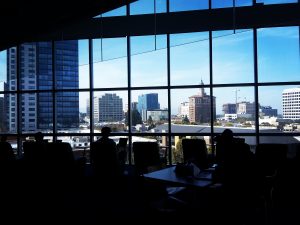Data current as of August 22, 2023.

The Bay Area Council Economic Institute and CBRE’s Tech Insights Center are partnering on a three-year, three-part series of interactive reports to evaluate and track key indicators of economic recovery in the Bay Area. The first part of this analysis, published below, tracks jobs, people, investment, economic activity, and affordability measured by: 1) an economic index tracking recovery across the nation’s 25 largest economic regions; and 2) a deeper dive into our region’s economic recovery.
Explore the Project
Key Findings
- Our regional economic recovery index ranks the San Francisco MSA 24th out of 25 peer regions, holding down its rank for the third quarter in a row. Austin ranks 1st, and San Jose ranks 19th. Index metrics include job and labor force growth, real estate activity, population growth, and changes to economic activity and affordability. (Scroll down for scores & methodology)
- The region fully recovered its pre-pandemic jobs in January 2023, but still lags behind the state and nation. Most of the region’s lag can be attributed to blows to the service and hospitality sectors that have yet to fully recover, and slower growth in “knowledge industries” e.g., tech, R&D, legal etc.
- The region saw a nearly five-fold increase in residents working from home from 2019 to 2021. But because office and tech work drives much of the Bay Area economy, our region is more susceptible to longer-lasting effects of remote work than its peers.
- The San Francisco and San Jose metro areas collectively lost 204,000 people during the pandemic, as people left for cheaper parts of the state, or more affordable states entirely (like Texas, Washington, and Oregon).
- In terms of office vacancy, San Francisco saw the largest increase within the region, experiencing a 25 percentage point increase from 4% vacancy in Q1 2020 to 29.4% by Q1 2023.
- Not accounting for fewer in-migrants, out of state moves were greater in 2021 than in 2019 — but not nearly as high as they were after the Great Recession. Top destinations for those who moved away from the region are largely still in California, though shares to out of state destinations have increased.
- The City of San Francisco collected $36 million fewer dollars (or -11%) in sales tax revenue in 2022 versus 2019, taking the hardest hit of any large West Coast city. Hotel revenues and air travel also continue to trail competing tourism destinations.
- The Bay Area continues to remain the epicenter of venture capital funding, bringing in over twice as many dollars per capita as Boston, the next highest funded region.
- As of March 2023, 32% of employers in the region say they’ve already reduced or consolidated their office space, and another 23% say they plan to reduce or consolidate their office space in the region over the next few years.
For questions about this project, please contact Abby Raisz, Senior Research Manager at the Bay Area Council Economic Institute at araisz@bayareacouncil.org.
Regional Economic Recovery Index
How has our region fared compared to peer regions?
Explore our regional economic recovery index for the 25 largest economic regions in the nation (based on regional GDP). The San Francisco-Oakland-Berkeley metro includes San Francisco, Alameda, Marin, Contra Costa, and San Mateo counties. The San Jose-Sunnyvale-Santa Clara metro includes Santa Clara and San Benito counties.
Regions are scored on 15 different metrics across 5 different categories: Jobs, People, Investment, Economic Activity, and Affordability. Scores are out of 100. A score of 100 indicates that a region ranked first on every metric, while a score of 0 indicates that a region ranked last on every metric.
For example, Austin scored 100 in the People category, meaning it had the highest rate of both population growth and labor force growth, the two metrics in that category. San Jose, San Francisco, and Los Angeles all scored the lowest because they experienced the greatest population and labor force losses given their pre-pandemic levels.
The index was first developed in January 2023, with most data reflecting Q4 2022. The index was then updated in May 2023, with most data reflecting Q1 2023. The newest update reflects Q1 2023. Changes in regional ranks and scores are shown below.
Regions are scored on 15 different metrics across 5 different categories: Jobs, People, Investment, Economic Activity, and Affordability. Scores are out of 100. A score of 100 indicates that a region ranked first on every metric, while a score of 0 indicates that a region ranked last on every metric.
For example, Austin scored 100 in the People category, meaning it had the highest rate of both population growth and labor force growth, the two metrics in that category. San Jose, San Francisco, and Los Angeles all scored the lowest because they experienced the greatest population and labor force losses given their pre-pandemic levels.
The index was first developed in January 2023, with most data reflecting Q4 2022. The index was then updated in May 2023, with most data reflecting Q1 2023. The newest update reflects Q1 2023. Changes in regional ranks and scores are shown below.
Economic recovery scores as of July 2023:
Bay Area Deep Dive
What’s driving the region’s recovery?

Economic Activity
How has economic activity been affected, particularly within leisure and hospitality sectors?
This ongoing research is generously supported by CBRE.





